Nitrogen and Rainfall Effects on Crop Growth—Experimental Results and Scenario Analyses
Abstract
:1. Introduction
2. Materials and Methods
2.1. ET Simulation in the RZWQM2
2.2. Experimental Design and Measurements
2.3. RZWQM2 Calibration
3. Results and Discussions
4. Conclusions
Author Contributions
Funding
Institutional Review Board Statement
Informed Consent Statement
Data Availability Statement
Conflicts of Interest
References
- Ahuja, L.; Ma, L. Parameterization of Agricultural System Models: Current Approaches and Future Needs; Agricultural System Models in Field Research and Technology Transfer; Lewis Publishers: Boca Raton, FL, USA, 2002. [Google Scholar]
- Ahuja, L.; Rojas, K.; Hanson, J.; Shaffer, M.; Ma, L. Root Zone Water Quality Model: Modeling Management Effects on Water Quality and Crop Production; Water Resources Publ., LLC: Highland Ranch, CO, USA, 2000; p. 372. [Google Scholar]
- Alves, I.; Maria, D.R.C. Evapotranspiration Estimation Performance of Root Zone Water Quality Model: Evaluation and Improvement. Agric. Water Manag. 2002, 57, 61–73. [Google Scholar] [CrossRef]
- Anapalli, S.S.; Ahuja, L.R.; Gowda, P.H.; Ma, L.; Marek, G.; Evett, S.R.; Howell, T.A. Simulation of Crop Evapotranspiration and Crop Coefficients with Data in Weighing Lysimeters. Agric. Water Manag. 2016, 177, 274–283. [Google Scholar] [CrossRef] [Green Version]
- Cameira, M.R.; Sousa, P.L.; Farahani, H.J.; Ahuja, L.R.; Pereira, L.S. Evaluation of the RZWQM for the Simulation of Water and Nitrate Movement in Level-Basin, Fertigated Maize. J. Agric. Eng. Res. 1998, 69, 331–341. [Google Scholar] [CrossRef]
- Cameira, M.; Fernando, R.; Ahuja, L.; Ma, L. Using RZWQM to Simulate the Fate of Nitrogen in Field Soil–Crop Environment in the Mediterranean Region. Agric. Water Manag. 2007, 90, 121–136. [Google Scholar] [CrossRef]
- Cameira, M.; Fernando, R.; Ahuja, L.; Pereira, L. Simulating the Fate of Water in Field Soil—Crop Environment. J. Hydrol. 2005, 315, 1–24. [Google Scholar] [CrossRef]
- Camillo, P.J.; Gurney, R.J. A Resistance Parameter for Bare-Soil Evaporation Models. Soil Sci. 1986, 141, 95–105. [Google Scholar] [CrossRef]
- Djaman, K.; Irmak, S. Actual Crop Evapotranspiration and Alfalfa-and Grass-Reference Crop Coefficients of Maize under Full and Limited Irrigation and Rainfed Conditions. J. Irrig. Drain. Eng. ASCE 2013, 433–446. [Google Scholar] [CrossRef]
- Fang, Q.; Ma, L.; Yu, Q.; Malone, R.; Saseendran, S.; Ahuja, L. Modeling Nitrogen and Water Management Effects in a Wheat-Maize Double-Cropping System. J. Environ. Qual. 2008, 37, 2232–2242. [Google Scholar] [CrossRef] [Green Version]
- Farahani, H.; DeCoursey, D. Potential Evaporation and Transpiration Processes in the Soil-Residue-Canopy System. In RZWQM, Modeling Management Effects on Water Quality and Crop Production; Ahuja, L., Rojas, K., Hanson, J., Shaffer, M., Ma, M., Eds.; Water Resources Publications, LLC: Littleton, CO, USA, 2000; pp. 51–75. [Google Scholar]
- Farahani, H.; Ahuja, L. Evapotranspiration Modeling of Partial Canopy/Residue-Covered Fields. Trans. ASAE 1996, 39, 2051–2064. [Google Scholar] [CrossRef]
- Farahani, H.; Bausch, W. Seasonal Application of Physical Evapotranspiration Models: Resistance Estimation; ASAE: St Joseph, MI, USA, 1994; Volume 4, p. 2547. [Google Scholar]
- Farahani, H.J.; Buchleiter, G.W.; Ahuja, L.R.; Peterson, G.A.; Sherrod, L.A. Seasonal Evaluation of the Root Zone Water Quality Model in Colorado. Agron. J. 1999, 91, 212–219. [Google Scholar] [CrossRef]
- Frimpong, J.O.; Addy, M.Q.; Ayeh, E.O.; Amoatey, H.M.; Kutufam, J.T.; Quaye, B.; Sintim, J.O.; Asare, D.K. Field Assessment of Soil Water Storage and Actual Evapotranspiration of Rainfed Maize (Zea mays L.) Genotypes in a Coastal Savannah Environment. Open J. Soil Sci. 2012, 2, 213–222. [Google Scholar] [CrossRef] [Green Version]
- Gheysari, M.; Mirlatifi, S.M.; Bannayan, M.; Homaee, M.; Hoogenboom, G. Interaction of water and nitrogen on maize grown for silage. Agric. Water Manag. 2009, 96, 809–821. [Google Scholar] [CrossRef]
- Ham, J.; Heilman, J. Aerodynamic and Surface Resistances Affecting Energy Transport in a Sparse Crop. Agric. For. Meteorol. 1991, 53, 267–284. [Google Scholar] [CrossRef]
- Hanson, J. Generic Crop Production Model for the Root Zone Water Quality Model. The Root Zone Water Quality Model; Water Resource Publishing: Highland Ranch, CO, USA, 2000. [Google Scholar]
- Hanson, J.; Ahuja, L.; Shaffer, M.; Rojas, K.; DeCoursey, D.; Farahani, H.; Johnson, K.; Team, R.D. RZWQM: Simulating the Effects of Management on Water Quality and Crop Production. Agric. Syst. 1998, 57, 161–195. [Google Scholar] [CrossRef]
- Hanson, J.D.; Rojas, K.; Shaffer, M.J. Calibrating the Root Zone Water Quality Model. Agron. J. 1999, 91, 171–177. [Google Scholar] [CrossRef]
- Hu, C.; Saseendran, S.; Green, T.; Ma, L.; Li, X.; Ahuja, L. Evaluating Nitrogen and Water Management in a Double-Cropping System Using RZWQN. Vadose Zone J. 2006, 5, 493–505. [Google Scholar] [CrossRef] [Green Version]
- Irmak, S.; Istanbulluoglu, E.; Irmak, A. An Evaluation of Evapotranspiration Model Complexity against Performance in Comparison with Bowen Ratio Energy Balance Measurements. Trans. ASABE 2008, 51, 1295–1310. [Google Scholar] [CrossRef]
- Kang, S.; Gu, B.; Du, T.; Zhang, J. Crop Coefficient and Ratio of Transpiration to Evapotranspiration of Winter Wheat and Maize in a Semi-Humid Region. Agric. Water Manag. 2003, 59, 239–254. [Google Scholar] [CrossRef]
- Kristensen, K. Actual Evapotranspiration in Relation to Leaf Area. Hydrol. Res. 1974, 5, 173–182. [Google Scholar] [CrossRef]
- Kumar, A.; Kanwar, R.S.; Singh, P.; Ahuja, L.R. Evaluation of the Root Zone Water Quality Model for Predicting Water and No 3–N Movement in an Iowa Soil. Soil Tillage Res. 1999, 50, 223–236. [Google Scholar] [CrossRef]
- Kunrath, T.R.; Lemaire, G.; Sadras, V.O.; Gastal, F. Water use efficiency in perennial forage species: Interactions between nitrogen nutrition and water deficit. Field Crop. Res. 2018, 222, 1–11. [Google Scholar] [CrossRef]
- Li, Y.; Cui, S.; Zhang, Z.; Zhuang, K.; Wang, Z.; Zhang, Q. Determining effects of water and nitrogen input on maize (Zea mays) yield, water-and nitrogen-use efficiency: A global synthesis. Sci. Rep. 2020, 10, 9699. [Google Scholar] [CrossRef]
- López-Bellido, L.; López-Bellido, R.J.; Redondo, R. Nitrogen Efficiency in Wheat Under Rainfed Mediterranean Conditions as Affected by Split Nitrogen Application. Field Crop. Res. 2005, 94, 86–97. [Google Scholar] [CrossRef]
- Ma, L.; Ahuja, L.R.; Saseendran, S.A.; Malone, R.W.; Green, T.R.; Nolan, B.T.; Bartling, P.N.S.; Flerchinger, G.N.; Boote, K.J.; Hoogenboom, G. A Protocol for Parameterization and Calibration of RZWQM2 in Field Research. In Methods of Introducing System Models into Agricultural Research; Ahuja, L.R., Ma, L., Eds.; SSSA Book Series; American Society of Agronomy: Madison, WI, USA, 2011; pp. 1–64. [Google Scholar]
- Ma, L.; Ahuja, L.R.; Ascough Ii, J.C.; Shaffer, M.J.; Rojas, K.W.; Malone, R.W.; Cameira, M.R. Integrating system modeling with field research in agriculture: Applications of the Root Zone Water Quality Model (RZWQM). Adv. Agron. 2001, 71, 233–292. [Google Scholar]
- Ma, L.; Nielsen, D.C.; Ahuja, L.R.; Malone, R.W.; Saseendran, S.A.; Rojas, K.W.; Hanson, J.D.; Benjamin, J.G. Evaluation of RZWQM under Various Irrigation Levels in Eastern Colorado. Trans. ASAE 2003, 46, 39–49. [Google Scholar]
- Ma, L.; Hook, J.; Wauchope, R. Evapotranspiration Predictions: A Comparison among Gleams, Opus, Przm-2, and RZWQM Models in a Humid and Thermic Climate. Agric. Syst. 1999, 59, 41–55. [Google Scholar] [CrossRef]
- Ma, L.; Ahuja, L.; Islam, A.; Trout, T.; Saseendran, S.; Malone, R. Modeling Yield and Biomass Responses of Maize Cultivars to Climate Change under Full and Deficit Irrigation. Agric. Water Manag. 2017, 180, 88–98. [Google Scholar] [CrossRef]
- Ma, L.; Malone, R.; Jaynes, D.; Thorp, K.; Ahuja, L. Simulated Effects of Nitrogen Management and Soil Microbes on Soil Nitrogen Balance and Crop Production. Soil Sci. Soc. Am. J. 2008, 72, 1594–1603. [Google Scholar] [CrossRef] [Green Version]
- Malone, R.W.; Ma, L.; Heilman, P.; Karlen, D.L.; Kanwar, R.S.; Hatfield, J.L. Simulated N Management Effects on Corn Yield and Tile-Drainage Nitrate Loss. Geoderma 2007, 140, 272–283. [Google Scholar] [CrossRef] [Green Version]
- Monteith, J.L. Evaporation and Environment. Symp. Soc. Exp. Biol. 1965, 19, 4. [Google Scholar]
- Nielsen, D. and A. Halvorson. Nitrogen Fertility Influence on Water Stress and Yield of Winter Wheat. Agron. J. 1991, 83, 1065–1070. [Google Scholar] [CrossRef] [Green Version]
- Nimah, M.; Hanks, R. Model for Estimating Soil Water, Plant, and Atmospheric Interrelations: I. Description and Sensitivity. Soil Sci. Soc. Am. J. 1973, 37, 522–527. [Google Scholar] [CrossRef]
- Novoa, R.; Loomis, R. Nitrogen and Plant Production. Plant Soil 1981, 58, 177–204. [Google Scholar] [CrossRef]
- Oweis, T.; Zhang, H.; Pala, M. Water use efficiency of rainfed and irrigated bread wheat in a Mediterranean environment. Agron. J. 2000, 92, 231–238. [Google Scholar] [CrossRef]
- Raun, W.R.; Johnson, G.V. Improving Nitrogen Use Efficiency for Cereal Production. Agron. J. 1999, 91, 357–363. [Google Scholar] [CrossRef] [Green Version]
- Reynolds, W.D.; Elrick, D.E. A Method for Simultaneous In Situ Measurement in the Vadose Zone of Field-Saturated Hydraulic Conductivity, Sorptivity and the Conductivity-Pressure Head Relationship. Groundw. Monit. Remediat. 1986, 6, 84–95. [Google Scholar] [CrossRef]
- Ritchie, J.; Johnson, B. Soil and Plant Factors Affecting Evaporation. Agronomy 1990, 11, 363–390. [Google Scholar] [CrossRef]
- Rudnick, D.R.; Irmak, S.; Djaman, K.; Sharma, V. Impact of irrigation and nitrogen fertilizer rate on soil water trends and maize evapotranspiration during the vegetative and reproductive periods. Agric. Water Manag. 2017, 191, 77–84. [Google Scholar] [CrossRef]
- Sadras, V.O.; Hayman, P.T.; Rodriguez, D.; Monjardino, M.; Bielich, M.; Unkovich, M.; Mudge, B.; Wang, E. Interactions between water and nitrogen in Australian cropping systems: Physiological, agronomic, economic, breeding and modeling perspectives. Crop Pasture Sci. 2016, 67, 1019–1053. [Google Scholar] [CrossRef] [Green Version]
- Saseendran, S.; Nielsen, D.; Ma, L.; Ahuja, L.; Halvorson, A. Modeling Nitrogen Management Effects on Winter Wheat Production Using RZWQM and CERES-Wheat. Agron. J. 2004, 96, 615–630. [Google Scholar] [CrossRef] [Green Version]
- Saseendran, S.; Ahuja, L.; Ma, L.; Nielsen, D.; Trout, T.; Andales, A.; Chávez, J.; Ham, J. Enhancing the Water Stress Factors for Simulation of Corn in RZWQM2. Agron. J. 2014, 106, 81–94. [Google Scholar] [CrossRef]
- Saseendran, S.; Ahuja, L.R.; Ma, L.; Trout, T. Modeling for Best Management of the Effects of Irrigation Frequencies, Initial Water, and Nitrogen on Corn. In Practical Applications of Agricultural System Models to Optimize the Use of Limited Water; Ahuja, L.R., Ma, L., Lascano, R.J., Eds.; Advances in Agricultural Systems Modeling; John Wiley & Sons: Hoboken, NJ, USA, 2014; Volume 5, pp. 25–52. [Google Scholar]
- Sexton, B.; Moncrief, J.; Rosen, C.; Gupta, S.; Cheng, H. Optimizing Nitrogen and Irrigation Inputs for Corn Based on Nitrate Leaching and Yield on a Coarse-Textured Soil. J. Environ. Qual. 1996, 25, 982–992. [Google Scholar] [CrossRef]
- Shaffer, M.J.; Ma, L.; Hansen, S. Modeling Carbon and Nitrogen Dynamics for Soil Management; CRC Press: Boca Raton, FL, USA, 2001. [Google Scholar]
- Shahadha, S.S.; Wendroth, O.; Zhu, J.; Walton, J. Can measured soil hydraulic properties simulate field water dynamics and crop production? Agric. Water Manag. 2019, 223, 105661. [Google Scholar] [CrossRef]
- Shuttleworth, W.J.; Wallace, J. Evaporation from Sparse Crops-an Energy Combination Theory. Q. J. R. Meteorol. Soc. 1985, 111, 839–855. [Google Scholar] [CrossRef]
- Shuttleworth, W.J.; Gurney, R.J. The Theoretical Relationship between Foliage Temperature and Canopy Resistance in Sparse Crops. Q. J. R. Meteorol. Soc. 1990, 116, 497–519. [Google Scholar] [CrossRef]
- Si, Z.; Zain, M.; Mehmood, F.; Wang, G.; Gao, Y.; Duan, A. Effects of nitrogen application rate and irrigation regime on growth, yield, and water-nitrogen use efficiency of drip-irrigated winter wheat in the North China Plain. Agric. Water Manag. 2020, 231, 106002. [Google Scholar] [CrossRef]
- Singh, A.K.; Tripathy, R.; Chopra, U.K. Evaluation of CERES-Wheat and CropSyst models for water—Nitrogen interactions in wheat crop. Agric. Water Manag. 2008, 95, 776–786. [Google Scholar] [CrossRef]
- Smith, R.; Barrs, H.; Fischer, R. Inferring Stomatal Resistance of Sparse Crops from Infrared Measurements of Foliage Temperature. Agric. For. Meteorol. 1988, 42, 183–198. [Google Scholar] [CrossRef]
- Srivastava, R.K.; Panda, R.K.; Chakraborty, A.; Halder, D. Quantitative estimation of water use efficiency and evapotranspiration under varying nitrogen levels and sowing dates for rainfed and irrigated maize. Theor. Appl. Climatol. 2020, 139, 1385–1400. [Google Scholar] [CrossRef]
- Szeicz, G.; Long, I. Surface Resistance of Crop Canopies. Water Resour. Res. 1969, 5, 622–633. [Google Scholar] [CrossRef]
- Wang, Z.; Qi, Z.; Xue, L.; Bukovsky, M.; Helmers, M.J. Modeling the Impacts of Climate Change on Nitrogen Losses and Crop Yield in a Subsurface Drained Field. Clim. Chang. 2015, 129, 323–335. [Google Scholar] [CrossRef] [Green Version]
- Yang, Y.; Wendroth, O.; Walton, R.J. Field-Scale Bromide Leaching as Affected by Land Use and Rain Characteristics. Soil Sci. Soc. Am. J. 2013, 77, 1157–1167. [Google Scholar] [CrossRef]
- Yu, Q.; Saseendran, S.A.; Ma, L.; Flerchinger, G.N.; Greenand, T.R.; Ahuja, L.R. Modeling a Wheat–Maize Double Cropping System in China Using Two Plant Growth Modules in RZWQM. Agric. Syst. 2006, 89, 457–477. [Google Scholar] [CrossRef]
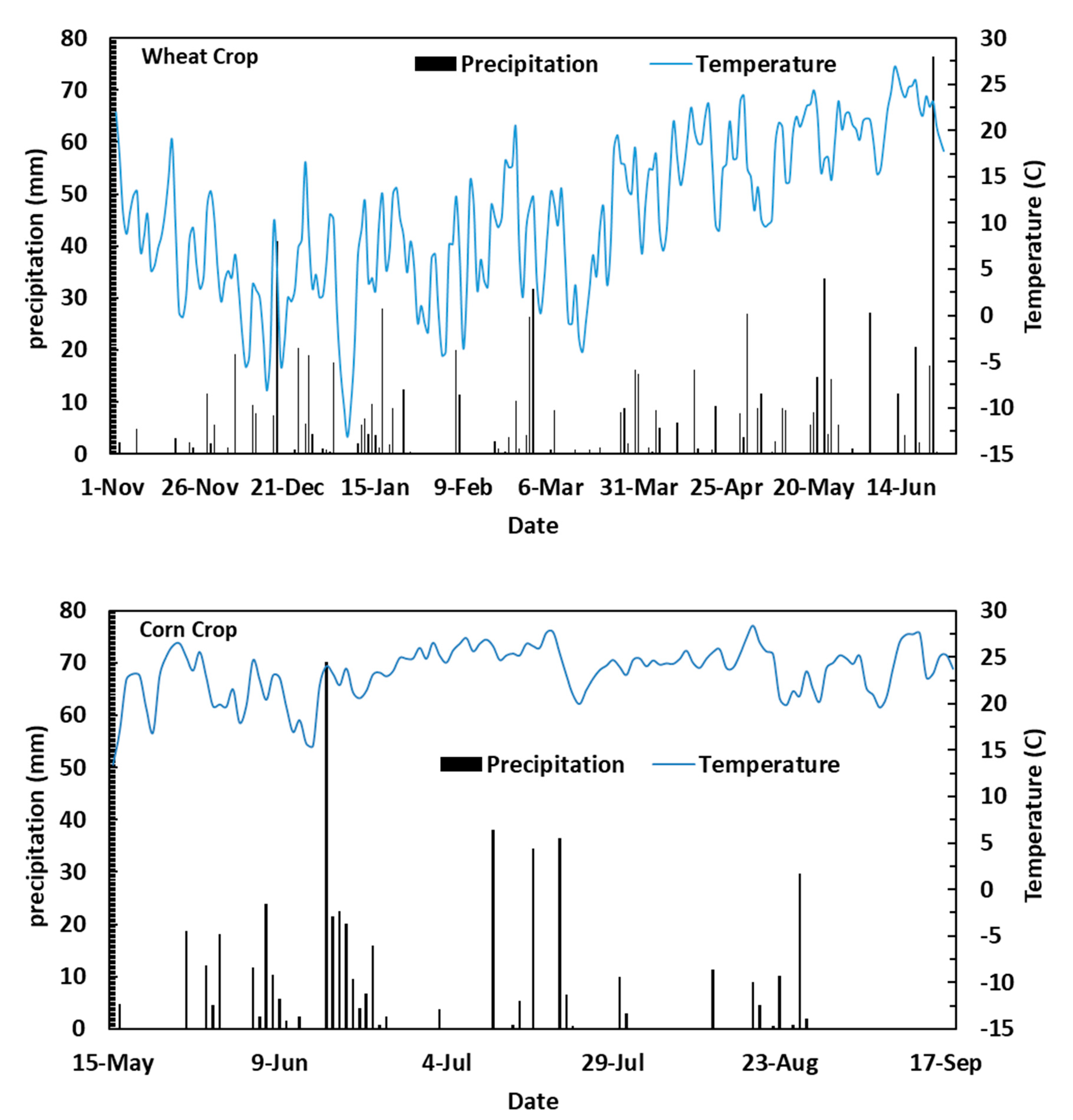
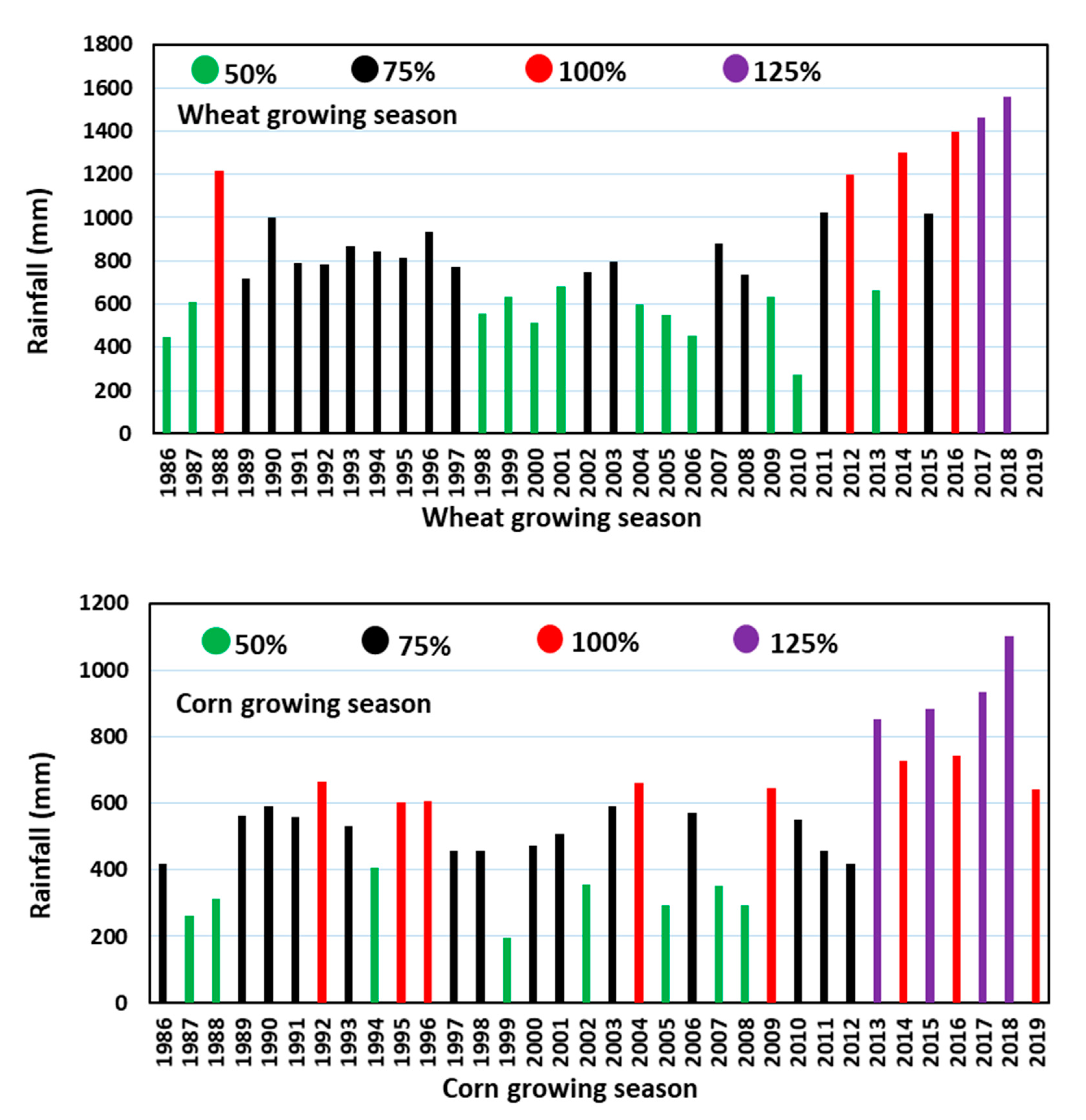

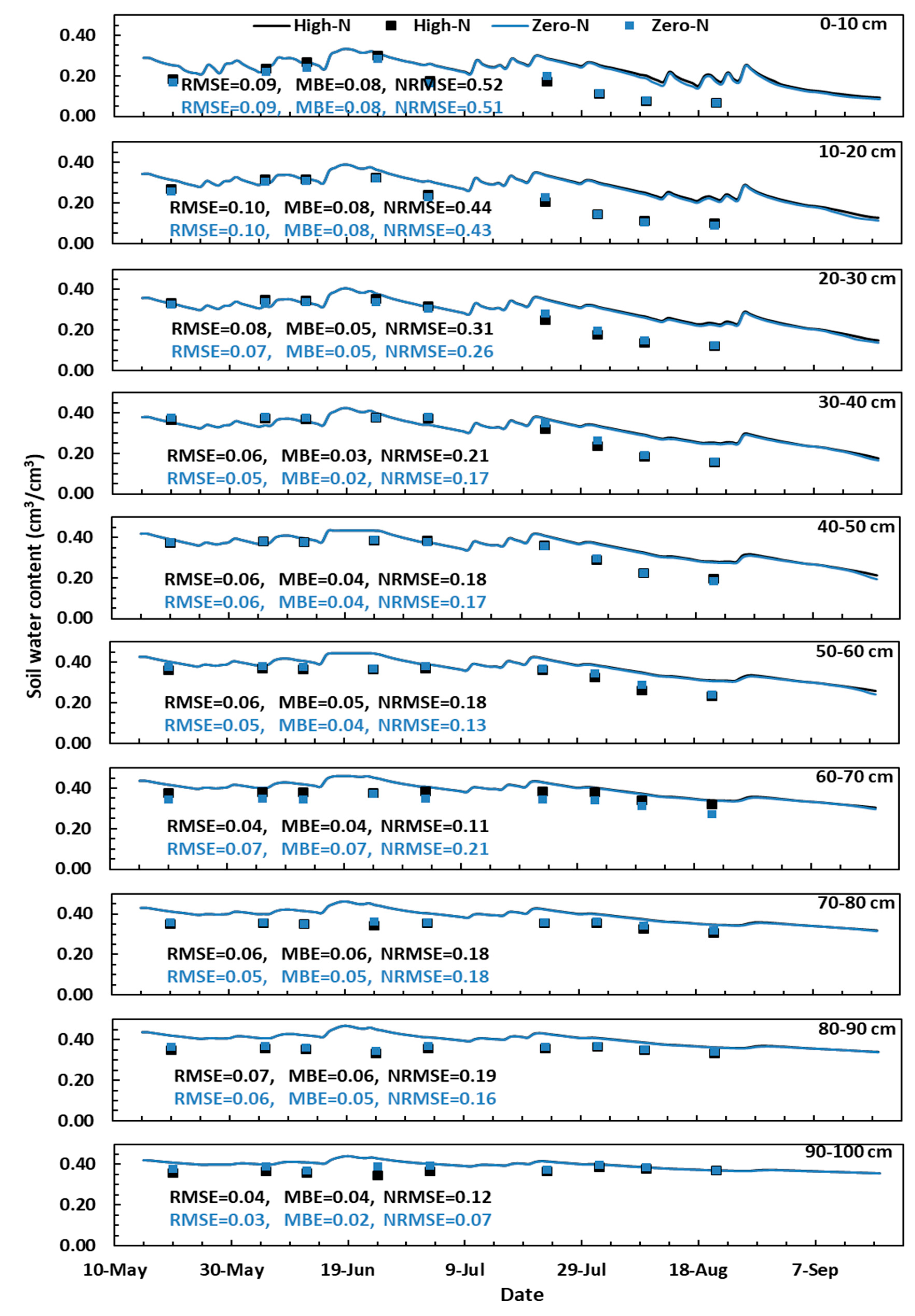



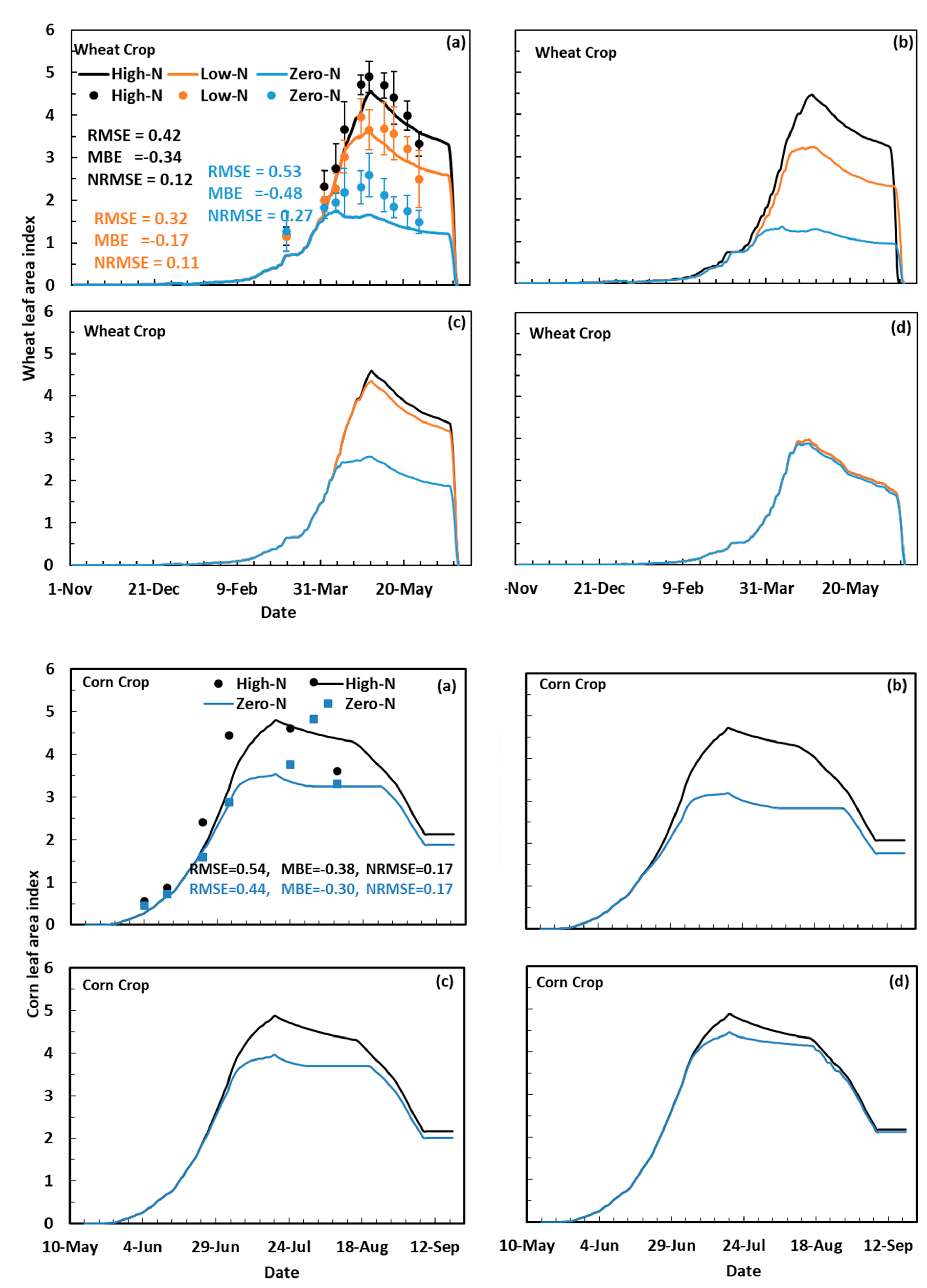


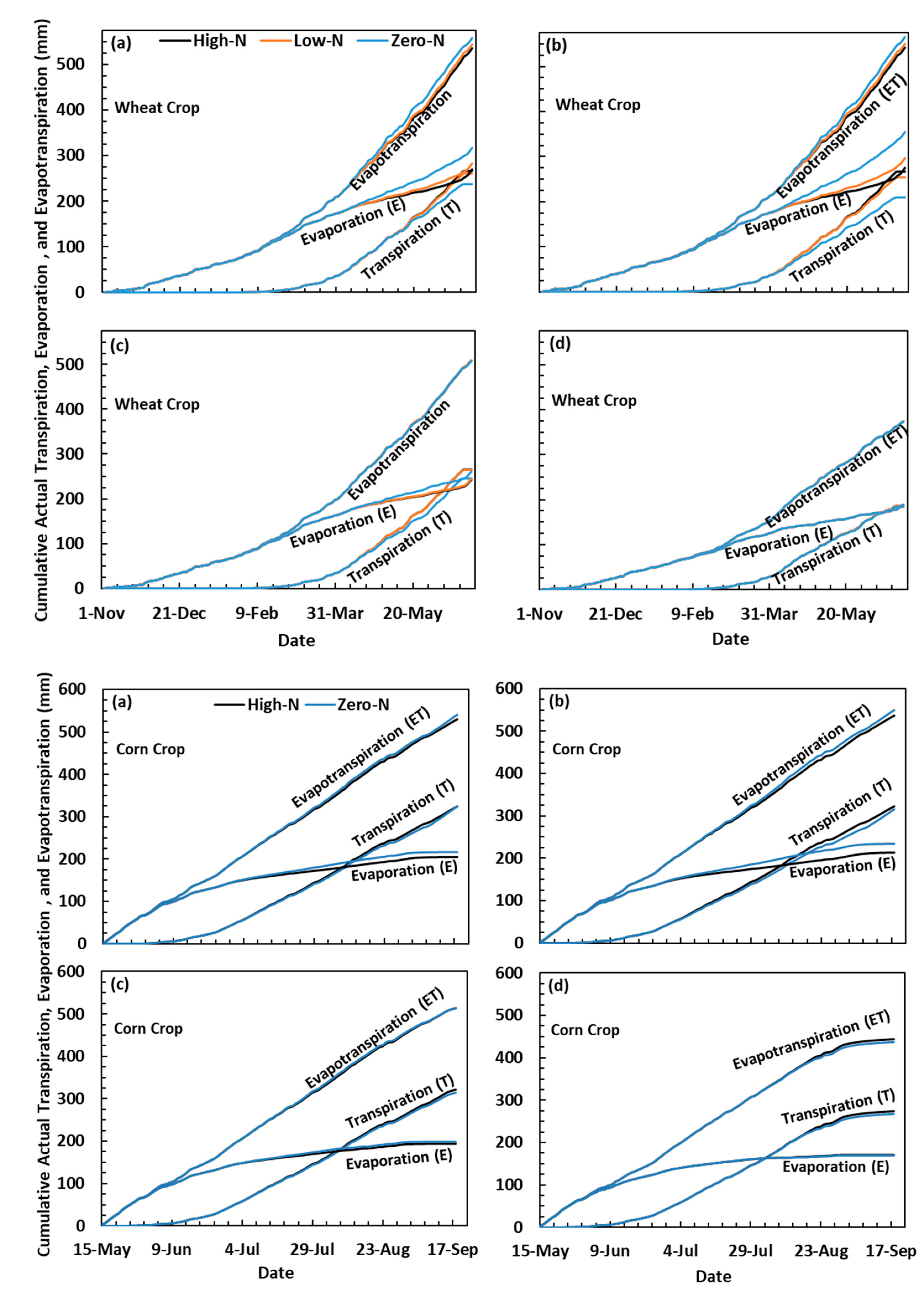
| Field Measurements | ||||||||
|---|---|---|---|---|---|---|---|---|
| Soil horizon | Particle fraction (%) | Bulk density | Ksat | Ө at 0.10 bar | Ө at 0.33 bar | Ө at 15 bar | ||
| (cm) | Sand | Silt | Clay | (g/cm3) | (cm/h) | (cm3/cm3) | (cm3/cm3) | (cm3/cm3) |
| 0–10 | 0.07 | 0.70 | 0.23 | 1.46 | 0.44 | 0.37 | 0.33 | 0.19 |
| 20–30 | 0.06 | 0.64 | 0.30 | 1.39 | 0.95 | 0.35 | 0.33 | 0.23 |
| 40–50 | 0.06 | 0.55 | 0.39 | 1.48 | 0.13 | 0.39 | 0.37 | 0.27 |
| 60–70 | 0.08 | 0.43 | 0.49 | 1.40 | 0.30 | 0.42 | 0.39 | 0.30 |
| 80–90 | 0.09 | 0.35 | 0.56 | 1.37 | 1.20 | 0.43 | 0.40 | 0.33 |
| After calibration | ||||||||
| Soil horizon | Particle fraction (%) | Bulk density | Ksat * | Ө at 0.10 bar | Ө at 0.33 bar | Ө * at 15 bar | ||
| (cm) | Sand | Silt | Clay | (g/cm3) | (cm/h) | (cm3/cm3) | (cm3/cm3) | (cm3/cm3) |
| 0–10 | 0.07 | 0.70 | 0.23 | 1.45 | 0.50 | 0.35 | 0.28 | 0.14 |
| 10–20 | 0.08 | 0.70 | 0.22 | 1.45 | 0.65 | 0.37 | 0.30 | 0.15 |
| 20–30 | 0.06 | 0.64 | 0.30 | 1.40 | 0.60 | 0.41 | 0.34 | 0.19 |
| 30–40 | 0.06 | 0.61 | 0.33 | 1.43 | 0.50 | 0.39 | 0.34 | 0.23 |
| 40–50 | 0.06 | 0.55 | 0.39 | 1.45 | 0.40 | 0.39 | 0.35 | 0.24 |
| 50–60 | 0.07 | 0.49 | 0.44 | 1.43 | 0.40 | 0.40 | 0.36 | 0.26 |
| 60–70 | 0.08 | 0.43 | 0.49 | 1.40 | 0.45 | 0.42 | 0.38 | 0.27 |
| 70–80 | 0.09 | 0.38 | 0.53 | 1.37 | 0.50 | 0.41 | 0.38 | 0.29 |
| 80–90 | 0.09 | 0.35 | 0.56 | 1.37 | 0.80 | 0.42 | 0.39 | 0.30 |
| 90–150 | 0.09 | 0.30 | 0.61 | 1.36 | 0.70 | 0.42 | 0.39 | 0.30 |
| Soil Horizon (cm) | %SOM | % N | %SOC | pH | %B.S. | CEC (meq/100 g) | NO3 (kg/ha) | NH4 (kg/ha) |
|---|---|---|---|---|---|---|---|---|
| 0–15 | 2.6 | 0.2 | 1.5 | 4.7 | 65.4 | 16 | 1.5 | 2.2 |
| 15–30 | 1.9 | 0.1 | 1.1 | 5 | 72.3 | 15.8 | 0.8 | 1.5 |
| 30–60 | 0.8 | 0.1 | 0.5 | 4.8 | 70.9 | 18.3 | 1 | 0.7 |
| 60–90 | 0.6 | 0.1 | 0.4 | 4.7 | 67.2 | 21.7 | 3 | 0.4 |
| Wheat cultivar Crop parameters of chosen wheat cultivar (990003 WINTER-US) | Calibrated |
| P1V: Days at an optimum vernalizing temperature required to complete vernalization | 38 |
| P1D: Percentage reduction in development when the photoperiod is 10 h less than the threshold (P1DT = 20 h) relative to that threshold | 98 |
| P5: Grain filling (excluding lag) phase duration (days) | 500 |
| G1: Kernel number per unit canopy weight at anthesis (#/g) | 26 |
| G2: Standard kernel size under optimum conditions (mg) | 27 |
| G3: Standard, non-stressed dry weight (total, including grain) of a single tiller at maturity (g) | 1.5 |
| PHINT: Interval between successive leaf tip appearances (days) | 100 |
| Corn cultivar Crop parameters of chosen corn cultivar (PC0004 2700-2750 GDD) | Calibrated |
| P1: Thermal time from seeding emergence to the end of the juvenile phase (days above 8 °C base temperature) | 240 |
| P2: Delay in development (days/h) for each hour that daylength is above 12.5 h (0–1) | 0.75 |
| P5: Thermal time from silking to physiological maturity (days above 8 °C base temperature) | 850 |
| G2: Maximum possible number of kernels per plant | 800 |
| G3: Kernel filling rate during the linear grain filling stage and under optimum conditions (mg/day) | 8.5 |
| PHINT: Phyllochron interval, i.e., the interval in thermal time (days) between successive leaf tip appearances | 49 |
| Maximum plant height at maturity (cm) | 250 |
| Plant biomass at half of maximum height (g) | 200 |
| Water Uptake (mm) | |||||
|---|---|---|---|---|---|
| 50% | 75% | 100% | 125% | ||
| High N | 186 | 266 | 267 | 267 | |
| Wheat | Low N | 186 | 265 | 261 | 254 |
| Zero N | 184 | 246 | 238 | 210 | |
| Corn | High N | 274 | 322 | 324 | 323 |
| Zero N | 268 | 314 | 324 | 315 | |
| Nitrogen Uptake (kg/ha) | |||||
| 50% | 75% | 100% | 125% | ||
| High N | 164 | 232 | 231 | 231 | |
| Wheat | Low N | 164 | 218 | 188 | 188 |
| Zero N | 160 | 158 | 122 | 122 | |
| Corn | High N | 291 | 316 | 315 | 313 |
| Zero N | 266 | 296 | 283 | 269 | |
| Water Use Efficiency | |||||
|---|---|---|---|---|---|
| 50% | 75% | 100% | 125% | ||
| High N | 2.1 | 1.4 | 1.3 | 1.2 | |
| Wheat | Low N | 1.8 | 1.1 | 1.0 | 0.9 |
| Zero N | 1.3 | 0.7 | 0.6 | 0.5 | |
| Corn | High N | 2.1 | 2.4 | 2.4 | 2.3 |
| Zero N | 1.9 | 2.2 | 2.1 | 2.0 | |
| Nitrogen Use Efficiency | |||||
| 50% | 75% | 100% | 125% | ||
| Wheat | High N | 22.3 | 26.3 | 28.4 | 28.7 |
| Low N | 25.6 | 29.8 | 32.0 | 32.2 | |
| Corn | High N | 5.6 | 6.7 | 7.3 | 7.4 |
Publisher’s Note: MDPI stays neutral with regard to jurisdictional claims in published maps and institutional affiliations. |
© 2021 by the authors. Licensee MDPI, Basel, Switzerland. This article is an open access article distributed under the terms and conditions of the Creative Commons Attribution (CC BY) license (https://creativecommons.org/licenses/by/4.0/).
Share and Cite
Shahadha, S.S.; Wendroth, O.; Ding, D. Nitrogen and Rainfall Effects on Crop Growth—Experimental Results and Scenario Analyses. Water 2021, 13, 2219. https://doi.org/10.3390/w13162219
Shahadha SS, Wendroth O, Ding D. Nitrogen and Rainfall Effects on Crop Growth—Experimental Results and Scenario Analyses. Water. 2021; 13(16):2219. https://doi.org/10.3390/w13162219
Chicago/Turabian StyleShahadha, Saadi Sattar, Ole Wendroth, and Dianyuan Ding. 2021. "Nitrogen and Rainfall Effects on Crop Growth—Experimental Results and Scenario Analyses" Water 13, no. 16: 2219. https://doi.org/10.3390/w13162219
APA StyleShahadha, S. S., Wendroth, O., & Ding, D. (2021). Nitrogen and Rainfall Effects on Crop Growth—Experimental Results and Scenario Analyses. Water, 13(16), 2219. https://doi.org/10.3390/w13162219







